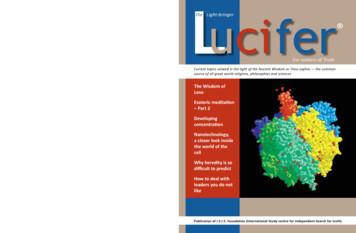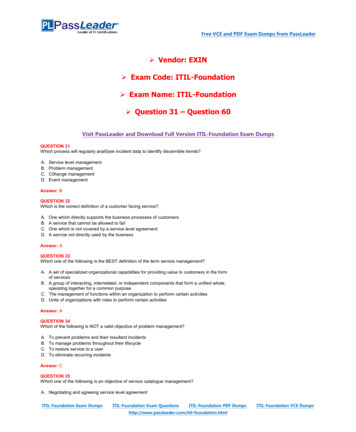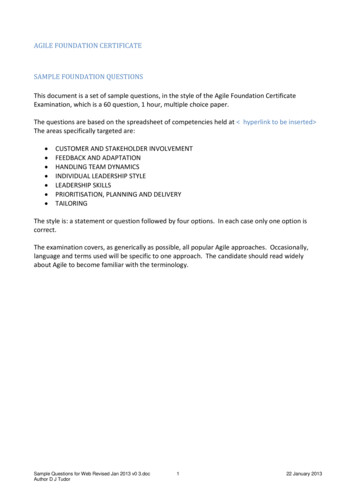
Transcription
I.S.I.S. FoundationThe activities of the I.S.I.S. Foundation (International Study-centre forIndependent Search for truth) are based on:1. The essential unity of all that exists.2. By reason of this unity: brotherhood as a fact in nature.3. Respect for everyone’s free will (when applied from this idea of universalbrotherhood).4. Respect for everyone’s freedom to build up their own view of life.5. To support the developing of everyone’s own view of life and itsapplication in daily practice.Luci ferthe Light-bringer For seekers of TruthCurrent topics viewed in the light of the Ancient Wisdom or Theo-sophia — the commonsource of all great world religions, philosophies and sciencesWhy this journal is called LuciferLucifer literally means Bringer of Light.Each culture in the East and West has his bringers of light: inspiringindividuals who give the initial impulse to spiritual growth and social reform.They stimulate independent thinking and living with a profound awarenessof brotherhood.These bringers of light have always been opposed and slandered by theestablishment. But there are always those who refuse to be put off by theseslanderers, and start examining the wisdom of the bringers of light in anopen-minded and unprejudiced way.For these people this journal is written.“ the title chosen for our magazine is as much associated with divine ideasas with the supposed rebellion of the hero of Milton’s Paradise Lost We work for true Religion and Science, in the interest of fact as againstfiction and prejudice. It is our duty – as it is that of physical Science – tothrow light on facts in Nature hitherto surrounded by the darkness ofignorance But natural Sciences are only one aspect of SCIENCE andTRUTH. Psychological and moral Sciences, or theosophy, the knowledge ofdivine truth, are still more important ”(Helena Petrovna Blavatsky in the first issue of Lucifer, September 1887)No. 4 December 2017The Wisdom ofLoveEsoteric meditation– Part 2DevelopingconcentrationPlaatje bij ISIS,Lucifer 1, 2015Nanotechnology,a closer look insidethe world of thecellWhy heredity is sodifficult to predictHow to deal withleaders you do notlikePublication of I.S.I.S. Foundation (International Study-centre for Independent Search for truth)
Lucifer ColophonI.S.I.S. FoundationEditors: Barend Voorham,Henk Bezemer, Rob Goor, BiancaPeeters, Erwin Bomas, Bouke van denNoort.The name of the Foundation [Stichting] is‘Stichting International Study-centre forIndependent Search for truth’. Its registeredoffice is in The Hague, The Netherlands.Chief editor: Herman C. VermeulenThe object of the Foundation is to forma nucleus of Universal Brotherhood bydisseminating knowledge about the spiritualstructure of human beings and the cosmos,free from dogma.Editorial office:De Ruijterstraat 72-74,2518 AV Den Haag,tel. 31 (0) 70 346 15 45e-mail: luciferred@isis-foundation.orgReactions:The Editorial Board reserves the rightto make a selection and/or shortenincoming documentsSubscription:This is the twelfth free sampleof Lucifer, the Light-bringer. Forsubscription: mail the editorial office:luciferred@stichtingisis.org.The price of our “paper” issues will beabout 4,60 and 9,20 for a doubleissue, excluding postage.Payment by Internet – creditcard (seewebsite).Cover photo:A model of an “F-ATPase”molecule that rotates around itsown axis. The released energyin this process is used to formnew energy-rich molecules —the ATPs.Publisher:I.S.I.S. Foundation, Blavatskyhouse,De Ruijterstraat 72-74,2518 AV Den Haag,tel. 31 (0) 70 346 15 45,e-mail: luciferred@isis-foundation.orginternet: www.blavatskyhouse.org I.S.I.S. FoundationNo part of this publication may bereproduced or made public in anyform or by any means: electronic,mechanical, by photocopies,recordings, or any other way, withoutprior permission of the Publisher.The I.S.I.S. foundation is notresponsible for any statement oropinion that is published in thismagazine, unless an explicit referenceis made.The Foundation endeavors to accomplish thisobject by giving courses, organizing public andother speeches and lectures, issuing books,brochures and other publications, and bydrawing on all other resources available to it.I.S.I.S. Foundation is a non-profit organization,which is recognized as such by the taxauthorities in The Netherlands. For the purposesof the tax authorities, I.S.I.S. Foundation haswhat is called ANBI status.ANBI stands for General Benefit Organisation(Algemeen Nut Beogende Instelling).The most important requisites in obtaining thisANBI status are: It is a non-profit organization, so it hasno earnings. Any profit earned from forexample book sales, must be fully usedfor general beneficial activities. For I.S.I.S.Foundation, this is spreading the Theosophia. (We refer to the statutes, aims andprinciples for further information.) Board members must meet integrity requirements. The ANBI must have a separate property,whereby a director or policymaker cannotdictate over this property as though it werehis own. The remuneration of board membersmay only consist of a reimbursement forexpenses and attendance.I.S.I.S. Foundation ANBI number is 50872.
No. 4 December 2017Contents Lucifer — the LightbringerEditorialp. 2The Wisdom of LoveOn the occult meaning ofPhilosophyp. 3Western philosophy hardly succeeds in givingmeaning to life, or in putting science in abroader, ethical perspective. What is lackingin western thinking? In order to answer this,we reflect on the occult (hidden) meaning ofphilosophy.Erwin BomasEsoteric meditation – Part 2Aids in developing the buddhicmindp. 7This article focuses on conditions andaspects of thinking which are useful in thedevelopment of higher consciousness andon the effects and the depth of esotericmeditation.Herman C. Vermeulenand Bianca PeetersMeditationp. 12The view on meditation of Gottfried dePurucker.G. de PuruckerDeveloping concentrationp. 14Teachers often complain that students havelost the ability to concentrate on their studies.What can we do to regain their attention?Barend VoorhamNanotechnology, a closer look insidethe world of the cellThe more microscopic we look, thebigger the questionsp. 19So-called nanotechnology allows us tostudy processes in the cell even down to themolecular level. A new world opens, makingalleged divisions of living and “non-living’fade away.Bouke van den NoortWhy heredity is so difficult topredictp. 25The more scientists discover about heredity,the more complex it turns out to be.Bouke van den NoortQuestions & Answers»31How to deal with leaders you do not like?Lucifer no. 4 December 2017 1
EditorialTheosophia: the synthesis of religion,philosophy and scienceTheosophia is the synthesis of religion, philosophy and science. This means that theWisdom-Religion is neither science, nor philosophy or religion, but it contains all thesethree elements, and forges them together in their highest, most universal aspects.In this issue of Lucifer, the Light-bringer, this is clearly reflected in the article ‘TheWisdom of Love’. This article offers a very interesting view on philosophy. It showsthat genuine philosophy cannot do without religion and science.Meditation is usually, and rightly so, regarded as something spiritual. Yet we cannotgrasp the idea of it if we do not involve philosophical and scientific elements. This isevident from the article ‘Esoteric Meditation’, of which the first part appeared in Lucifer,the Light-bringer, No. 3, August 2017.The article ‘Developing Concentration’ interconnects well with ‘Esoteric Meditation’, andit also shows that concentration serves our daily life and is necessary for all objectives.The articles ‘Nanotechnology, a closer look inside the world of the cell’ and ‘Whyhereditary is so difficult to predict’ seem to be typical scientific articles. But if youapproach these subjects from a scientific point of view only, a certain ‘mental lameness’arises, while if you involve the religious and philosophical thinking faculties as well,you will develop a completely different view on these two important issues.Our articles are not theoretical treatises, but as always we try to demonstrate the practicalvalue of Theosophia. The applicability of Theosophia is also apparent from the answerto a question about current world politics.As always, we welcome your comments, because they encourage us to express Theosophia more clearly.The editors2 Lucifer no. 4 December 2017
Erwin BomasThe Wisdom of LoveOn the occult meaning ofPhilosophyWestern philosophy hardly succeeds in giving meaning to life, or in putting science in a broader, ethical perspective. What is lacking in western thinking? In order to answer this, we reflect on the occult (hidden)meaning of philosophy.Key thoughts»There is a differencebetween occult Philosophy andphilosophy.»Religion without Philosophydegenerates in superstition.Philosophy without religiondegenerates in an empty wordgame, unpractical and heartless.»Philosophy has a connectingfunction. Connected withReligion on the one hand andScience on the other, it canprovide logical as well as ethicalclues for our actions in daily life.Studies in humanities have a hardtime nowadays. So hard that students occupy buildings in order tosafeguard a place for these studies atuniversities. They stand up againstthe current economic way of thinking which focuses solely on directuse for the short term. ‘What canyou do with it?’ is the most commonquestion asked. As a result, humanities such as philosophy come underpressure.However, if we take a wider look atthe results and look beyond economicwelfare, you may wonder whether thequestion what current philosophycontributes to society may be partlyjustified. Because, to what extent doesmodern western philosophy contribute to solving problems in the world?Does philosophy succeed in givingmeaning and direction to life? Doesit help to put scientific discoveriesin a wider perspective and connectit with ethics?What is the meaning and functionof philosophy, how can it fulfil these,and show its added value in society?In order to answer this, it is worth toreflect on the occult (hidden) meaning of philosophy.What is philosophy?When you look at the origin of theword philosophy, you see it consistsof two Greek words ‘philo’, whichmeans love, or to love, and ‘sophia’,which means wisdom. Usually, thisis translated literally in ‘love forwisdom’. However, according toH.P. Blavatsky the occult meaningis better expressed in the translation‘Wisdom of Love’.(1) She indicatesthat love should not be seen herein the meaning of ‘affection’ or ‘tolove’, but in the meaning of the Greekword ‘Eros’, which she translates with‘divine love’.In this occult meaning lies an important key leading to the meaningand function of philosophy. In orderto understand this well, we first haveto reflect on the meaning of ‘Eros’ asuniversal Love.Lucifer no. 4 December 2017 3
What is Love?In Theosophy, a distinction is made between love writtenin lower-case and Love written with a capital letter. The latter is sometimes described as a cosmic power, ‘the Cementof the Universe’, or ‘divine desire’. It is the bridge betweenthe spiritual and the material, the power that connectsthings and which, at the most material level, expressesitself in phenomena like magnetism and electricity.(2)In the dialogue Symposion Plato describes Eros, representing Love, as an intermediary between the divine and thehuman: not a god but rather a force of nature. Love is adesire for something you do not possess yet. Otherwise,you would not long for it. In essence, love is the desire forimmortality, Plato writes.(3) And the highest form is thelove for Truth, the Good, the Beautiful, for the One thatis the source of all phenomena (see text box).A thought you can trace back to the philosopher Pythagoras, H.P. Blavatsky writes. For him, Wisdom of Lovemeant the attraction to and the love for everything behindobjective reality. It was the highest form of initiation:love for and identification with the inner god. And in hismodesty Pythagoras even refused to be called Philosopher,which meant for him someone who had knowledge ofall that is hidden behind the outer phenomena, who hadknowledge of cause and effect or absolute truth.(7)According to Theosophia, compassion is one of the highestforms of love. And, since compassion is the Law of Laws,(8)in line with Pythagoras, Wisdom of Love can be seen asThe various forms of loveLove, in an abstract sense, can be seen as an impetus,a force of desire. In essence it is neutral by nature,but depending on how it is used it has a differentform of expression. If we take the following sevenprinciples, which can be distinguished at all levelsof the Cosmos, in the macrocosmos as well as in themicrocosmos that man is, then analogically, love issevenfold as well.1.ImpersonalPersonal3.Ātman – the divine, the One,the universalBuddhi – the principle ofenlightenment, the spiritualManas – thinking4.5.6.7.Kāma – desirePrāna – vitalityLinga-Śarīra – emotionSthūla-Śarīra – the physical2.In daily life, we see love, written in lowercase, usuallyin the personal form, focused on the physical, theemotional or desire.However, noble and even divine desires also exist. Forexample, there is desire for wisdom – philosophy –and the healthy curiosity to more knowledge, whichat first often expresses itself in wonderment. Bothare impersonal by nature. In its highest cosmic form,Love – like the divine Eros – is seen as the power thatbinds spirit and matter at the first manifestation. (4)And compassion can also be seen as one of thehighest forms of impersonal love.(5) It is the desirefor immortality, for unity, not for oneself but for allsentient beings.4 Lucifer no. 4 December 2017It is impersonal love which has to guide thedevelopment of wisdom. And vice versa love alsohas to be guided by wisdom, impersonal thinking.Desire is the horse, thought is the rider. Wisdom andcompassion are inseparably interconnected.Historically, the ‘philosophers’ who applied thisdesignation in its original meaning, like Pythagorasand Plato, were initiated in Theosophia, the AncientWisdom that was only taught within the walls ofthe Mystery-School in order to protect it frommisuse. Bound to this secrecy, Plato always veiledthe teachings from the Mysteries with myths andmetaphors in his dialogues. Consequently, it becomesclear that these teachings were connected with thedivine, the mystical, that which transcended man.The sevenfold can also be found in Plato’s dialogueSymposion, for instance in the following words fromDiotima, a wise woman who initiates Socrates in theMysteries of Love (with a capital letter):‘After all, this is the right way to reach the mysteriesof love or to be guided to it by someone else: you startwith the beautiful things around us and you have theBeauty as your aim. That way you move up. Compare itto the stairs of a staircase: from one beautiful body (7)to two beautiful bodies (6), from two to all beautifulbodies (5), and then from the beauty of the bodies tothe beauty of customs (4), and from the customs to thebeauty of the sciences (3) and finally, from the sciencesto that one science which is only dealing with Beautyitself (2), so that in the end you come to know Beauty inits essence (1).’ (6) [numbers added by E.B.]
knowledge of the background of nature and the laws thatgovern the universe.From this point of view, the contemporary term philosophyin the West is somewhat narrowed. However, for the sakeof completeness, it is good to reflect also on the othercomponent of the term philosophy, namely ‘Wisdom’.What is Wisdom?When we look at the origin of the word, ‘wisdom’ comesfrom the root ueid- (proto-Ido-European) which means ‘tosee’, and it is also derived from the Sanskrit ‘veda’, whichmeans ‘to know’. Both derivations can also be found in theword ‘vision’. To see is to know, or, as the famous Dutchsoccer player and ‘philosopher’ Johan Cruijff would say:‘you will not see it until you see through it’. In generalwisdom is considered as the highest knowledge based oninsight and life experience (and acting in accordance).Here, Wisdom rather refers to inner knowledge thanto outer knowledge. It is a matter of not just having aninsight or a vision, but a vision on and insight in realityin the widest possible sense. Therefore, wisdom can alsobe defined as the knowledge of, the starting point foractions and the application of Truth, in the widest sense.When your starting point is Theosophia, then Truth isboundless. It is the one, absolute Reality which precedesall manifested limited being.(9)Therefore, wisdom is always a relative notion. It is thehighest knowledge of that part of absolute Reality whichyou have experienced consciously, whereby you have alsorealized the limitation of the part you do not know fromyour own experience yet. Or in other words, the moreyou know, the more you know what you do not know.So, wisdom always ensures modesty, as was applicable toPythagoras, and also to Socrates, who was, stated by theoracle of Delphi, the wisest man of Athens. According tohimself because he at least ‘knew that he knew nothing’,unlike many who believed they knew, but knew nothing. (10) In the case of Socrates’, ‘knowing nothing’ meantthat he knew the limitations of his knowledge, rather thanthat he was ignorant. From the statement that the absoluteTruth is boundless, and that each human expression orcomparison with it is therefore meaningless, you can cometo realize that you will never have the answer to everything.The modesty of being aware of your own knowledge keepsyou open to a greater truth, beyond your widest vision.Wonderment is the start of philosophy, as Plato writes. (11)And growth in wisdom is always possible, this notionitself is also wisdom!Finally, when you look at the three highest principlesin the sevenfold composition in nature: Ātman, Buddhi and Manas (see text box), you will see that wisdomcorresponds to the sixth principle Buddhi, the principleof enlightenment. In our human thinking faculty thisprinciple expresses itself in idealism, insight or intuition,it is this thinking aspect with which we see cohesion andactivate discernment, something we could call philosophical thinking. It is the bridge between the highestĀtmic thinking aspect, the religious or coherent (religare)thinking, which we can recognize as sense or experienceof unity, and the Mānasic thinking aspect, which we canrecognize as the scientific, intellectual, systematic andlogically reasoning thinking.With all this, we come to a more complete picture of themeaning and the function of philosophy.The function of philosophySo, philosophy has a particularly unifying function, between the religious and the scientific, between ethics andlogic, between Love and Wisdom. When you look backin history, you can see that in periods in which religionhad the upper hand, for example during the Middle Ageswhen the Christian Church dominated the West, logic wasundermined, religion became dogmatic, and the voice ofdoom dominated the vision on life. In periods in whichscience dominates, however, such as today, you see thatethics are undermined and science becomes dogmatic,resulting in a materialistic and hedonistic vision on life.In this respect, philosophy particularly has the task toconnect logic to the religious, and from there ethics tothe scientists.When you define Religion in accordance with its origin, asreconnecting with the essential unity of all that is, moreover with an element of conscious independent selectionin it,(12) you have the right starting point for philosophy.Religion without philosophy results in superstition andphilosophy without religion degenerates into an emptyword game, unpractical and meaningless, despite all logicconsistency.Philosophy without religion is dominant in contemporarywestern philosophy. Consequently, it has become a stereotype of a mainly materialistic and fragmented science.In this time in which true religion can be seen as the babythat has been thrown out with the “religious” bathwaterof superstition, sense of unity and interconnectednessare badly missed. It has resulted in a materialistic viewon the world, in which everything that is scientificallyLucifer no. 4 December 2017 5
possible is pressed to function the selfish personal man,from clinical animal testing to heartless stigmatizationof people with ‘disorders’ which are only determined onthe basis of external characteristics and can be ‘cured’with profitable pills, produced by the same industry thattalks you into suffering from disorders. Ethics have beendegenerated into the emotional veneer with which thecold materialistic excesses are excused instead of beingfounded on the basis of a universal sense of unity andcompassion, logically as well as truly ethical.What is lacking is a life philosophy that can offer ananswer to all ethical questions in life, and which is logically consistent, scientifically verifiable and practicallyapplicable. Only a life philosophy based on the synthesisof Religion, Philosophy and Science, or Theosophia, canmeet this need. Where true religion focuses on the whatof things, philosophy on the why and science on the how,it is also in this (deductive) order that one of them can,ethically as well as logically, build on the other. Whencombined these three ways lead to Truth but they havenowadays become separated and are applied in the reverse(inductive) order. As soon as science discovers a how in acertain field and the discovery can be transformed intotechnology, it is already placed on the market before thewhy is clear and the (to) what (end?)-question is even asked.Luckily, man gradually realizes that this materialisticroad will finally and literally come to a dead end, andpeople start to search for the meaning of things. It isabout time that philosophy fulfils its function again. Itcan only do so when it is connected with religion andprovides science the necessary cohesion as well as soundand virtuous hypotheses.6 Lucifer no. 4 December 2017References1.H.P. Blavatsky, “The Origin of the Mysteries”. In: H.P.Blavatsky Collected Writings. The Theosophical PublishingHouse, Wheaton 1990, Vol. 14, p. 255.2. Joop Smits, “Emanation and Fohat as the fundament for theelectric universe”. Article in Lucifer, the Light-bringer, No.1,March 2015, pp. 20-30.3. Plato, Symposion, 207a.4. G. de Purucker, Esoteric Teachings, Vol. V, Hierarchies andthe Doctrine of Emanations. Point Loma Publications, SanDiego 1987, p. 16.5. G. de Purucker, Esoteric Teachings, Vol. X, The Hierarchy ofCompassion. Point Loma Publications, San Diego 1987, pp. 78-79.6. Plato, Symposion, 211c7. See ref. 4.8. H.P. Blavatsky, The Voice of the Silence. The TheosophicalPublishing House, Wheaton 1992, p. 69.9. H.P. Blavatsky, The Secret Doctrine. Theosophical UniversityPress, Pasadena 1988, Vol. I, p. 14.10. Plato, Apologia, 21d.11. Plato, Theaitetos, 155d.12. Barend Voorham, “Een andere kijk op de Islam” [“Anotherview on Islam”]. Article in the Dutch Lucifer, de LichtbrengerNo. 2, April 2015, pp. 50-54.
Herman C. Vermeulen and Bianca PeetersEsoteric meditation– Part 2Aids in developing the buddhic mindKey thoughts»Mantras, mandalas andthankas can help you to focusyour mind on the spiritual, sothat you’ll come to an intuitiveunderstanding of the nature ofthe Universe.»Meditation leads to selftransformation. If you trainyour spiritual awareness, yourphysical side will change with it.»If you get used to focusyour thinking on the highercharacteristics, you can underany circumstances and at anytime, go into meditation.»Meditation remains limitedto contemplation. Much moreimportant is that you dosomething with the results ofmeditation, that you becomewhat you have learned.»Achieving the nirvanic stateis a side issue for the Wise, nota goal.In the first article on meditation(1) we have sketched a picture of meditation as seen in Theo-sofia: if you assume the unity of all life, meditationis a tool for the development of the spiritual core that is present in everyhuman being. By developing wisdom and compassion, the reach of yourconsciousness increases and you are in a better position to help humanity and all other living beings in their development.In Part 1 we looked at tips that are especially useful if you are just starting out with meditation. Then creating a good environment and thebuilding of discipline is of interest.This article focuses on conditions and aspects of thinking which areuseful in the development of higher consciousness or buddhic power.Next we focus on the effects and the depth of esoteric meditation.MantraReal meditation is ‘dhyāna’; literallymeaning contemplation.By focusing your thoughts on thespiritual, you will come to an intuitive understanding of the nature ofthe Universe. Tools to boost dhyānacan be found in various cultures. Oneof the most famous of these is themantra.Mantra is a Sanskrit word derivedfrom the verb root ‘man’, whichmeans thinking.(2) A mantra helpsyou to direct your thoughts. TheHindu holy books, the Vedas, contain mantras. In their core these aremagic formulas, spells, you mightsay. Each letter has a specific occultsignificance. Behind the meaning ofthe signs, the meaning of the wordsthemselves, the esoteric meaning ofa mantra is hidden. Especially thevowels have magical power, if they arepronounced correctly. You must bea Sanskrit expert to be able to do so.Sound thus plays an important role.It is a powerful tool to make contactwith ‘higher’ spheres.(3) ‘Chanting’means the continuous repetition ofa mantra. The magical power of themantras can only be used if you havemade yourself fit. That is, if yourlife attitude is above-personal andunselfish.Om Mani Padme HumIn mantras often the word ‘Om’ or‘Aum’ occurs. It is a sacred syllableLucifer no. 4 December 2017 7
used by chelas (students of the Masters of Wisdom andCompassion) and initiates during holy gatherings. Theword, the sound of it, should not be expressed outside asacred environment. This means that without the propertraining, without your having internally been througha certain development, pronouncing this word evokes amagical power that you cannot handle. Only when youhave developed something of that power within yourselfcan you then create the circumstances in which pronouncing this word has a beneficial effect.The syllable occurs in the famous Tibetan mantra “OmMani Padme Hum”.(4) We can translate this as ‘Om! thejewel in the lotus Hum!’ It is one of the most famousmantras. There are many different interpretations of thismantra in circulation. This shows that the idea behind itis rather diverse. But there is consensus that ‘the jewel inthe lotus’ represents a highly developed consciousness — aBodhisattva. It is a consciousness of a certain quality. Thelotus is a beautiful, pure white flower that grows with itsroots in the deepest layers of mud on the bottom of a lake,in other words in matter. The mantra says you can growfrom that depth, the material level to the surface, to theThe Dalai Lama on Om mani padme humIt is very good to recite the mantra Om manipadme hum, but while you are doing it, you shouldbe thinking on its meaning, for the meaning of thesix syllables is great and vast The first, Om [ ]symbolizes the practitioner’s impure body, speech,and mind; they also symbolize the pure exaltedbody, speech, and mind of a Buddha [ ]The path is indicated by the next four syllables.Mani, meaning jewel, symbolizes the factorsof method: (the) altruistic intention to becomeenlightened, compassion, and love [ ]The two syllables, padme, meaning lotus, symbolizewisdom [ ]Purity must be achieved by an indivisible unityof method and wisdom, symbolized by the finalsyllable hum, which indicates indivisibility [ ]Thus the six syllables, om mani padme hum, meanthat in dependence on the practice of a path whichis an indivisible union of method and wisdom, youcan transform your impure body, speech, and mindinto the pure exalted body, speech, and mind of aBuddha [ ](Source: http://www.tibet.com/Buddhism/om-mantra.html)8 Lucifer no. 4 December 2017light. You may look upon the whiteness, the purity of thelotus as the symbol of a quality that you can express. So,in pronouncing the mantra, you make an appeal to bringout the highest in yourself.MandalaYou can also practice your intuition using a mandala. Weall know the sand mandalas made by Tibetan monks.Mandala in Sanskrit means ‘circle; it is a geometric figuredisplaying the structure of the universe in a particularsymbolic way. Pythagoras, who was initiated into theEastern secret wisdom, tried to explain to the Westernworld that everything is cyclical movement, rhythm, andsynchrony. Mandalas are examples of the universality,harmony, the geometry of the universe. They help youto think about what harmony is and what spiritualityis. Inner harmony can be found in the external world, ifthat is not disturbed by all kinds of personal elements.You should be able to recognize harmony and cyclicalmovements as forms of inspiration to get you to a certainspiritual level. You can create or look at a mandala by wayof meditation practice and thereby deepen your thoughtsabout harmony and the coherence of things.ThankaA thanka is a painted or embroidered piece of cloth thatserves as a teaching material in Buddhism. Often scenesfrom the life of Buddha or the teachings on the Path ofEnlightenment are depicted.On Tibetan thankas the 15th-century Teacher Tsong-khapa is a favorite subject. This Bodhisattva (subsequentlybecoming a Buddha) had purified Buddhism in Tibetand founded the Gelukpa order, also known as the Orderof the yellow caps. The thanka on page 9 depicts thespiritual evolution of Tsong-kha-pa. See in the middle theilluminated figure surrounded by the stages he has gonethrough to achieve that state. Each stage represented is ameditation exercise. You can pass through all the phasesand imagine that he went through t
Lucifer no. 4 December 2017 1 Contents Lucifer — the Lightbringer Editorial p. 2 No. 4 December 2017 Questions & Answers 31 » How to deal with leaders you do not like? The Wisdom of Love On the occult meaning of Philosophy p. 3 Western philosophy hardly succeeds in giving meaning to life, or in putting science in a broader, ethical .











